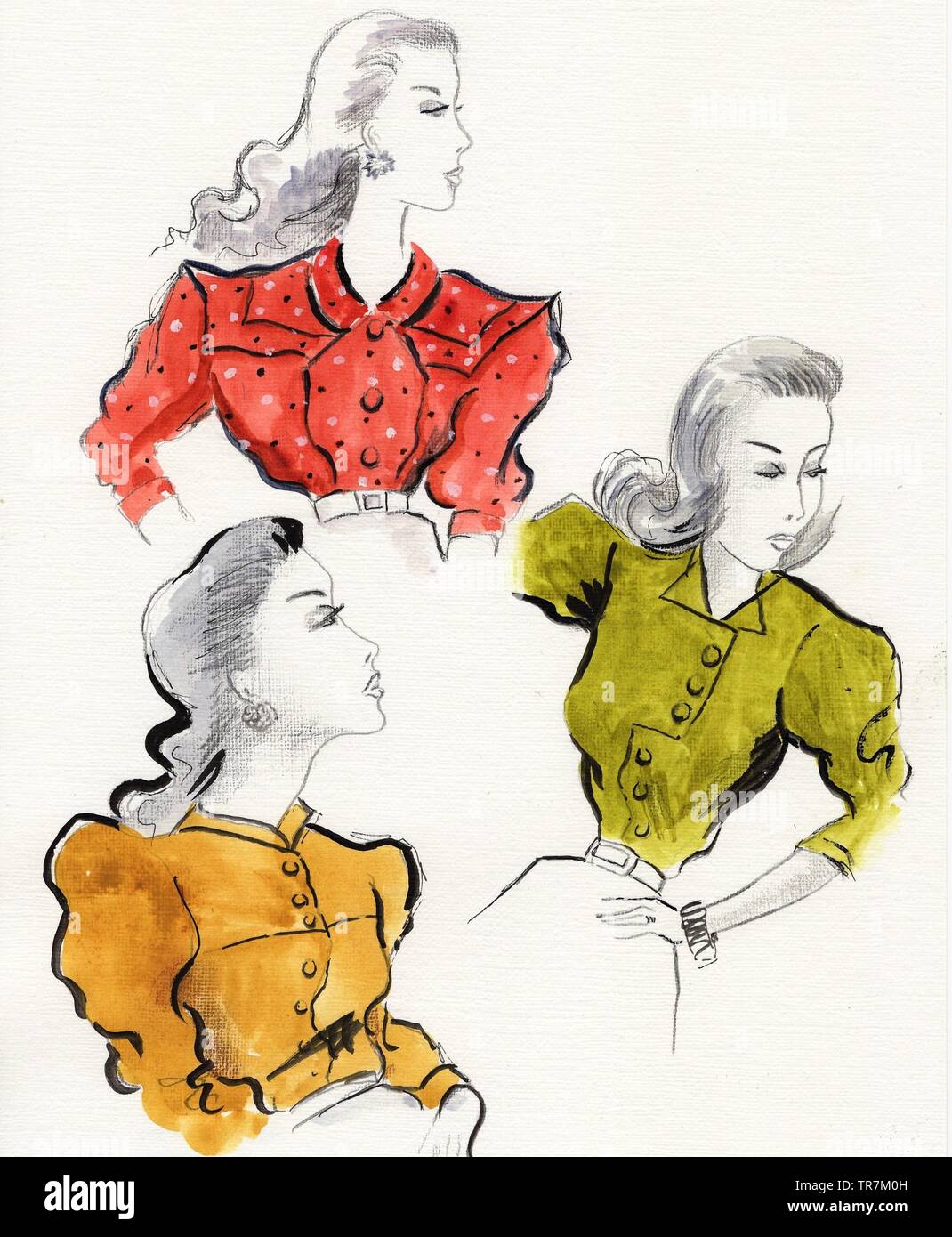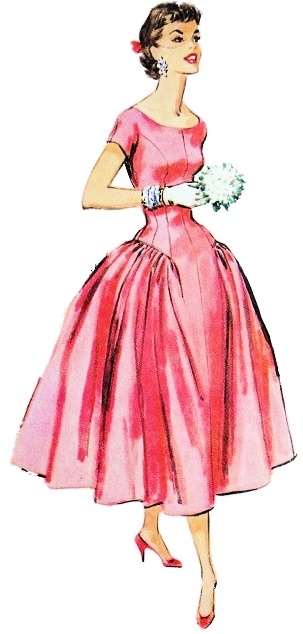In-Depth 1940s Fashion Profiles. 1940s Fashion: Women & Girls » Even though the 1940s fashion. However, the privileged status of fashion drawing faded rapidly during the 1950s, and photography soon gained more prominence in post-war magazines that wanted harder-hitting imagery. 21) This image was drawn for Harper's Bazaar around 1955. Did you scroll all this way to get facts about 1950s fashion images? Well you're in luck, because here they come. There are 401 1950s fashion images for sale on Etsy, and they cost $5.90 on average. The most common 1950s fashion images material is wood & hardboard. The most popular color? You guessed it: black.
1950s Fashion Overview
To think of 1950s fashion is akin to a bright summers day! Glamourous shapes, colourful prints and always exaggerated with voluminous skirts and tiny waists.
The 50s Silhouette
There are two main silhouettes in 50s fashion – the wasp waist with full skirt and the slim fitting pencil skirt. Both are iconic 50s looks that prevailed until 1956 and can be portrayed as super sexy or fun and flirty – depending on how you wear them.
The beauty of the 1950s era is that there is a ‘look’ that will suit any body shape – the more womanly the better. For those of us who lack curves, these can be created easily with a bit of help from belts, foundation garments and plenty of net and padding!
A bit of History
To understand the clothing of this era, one must understand what was really going on and how it influenced everyone’s way of life and subsequently how they expressed themselves through dress.
Let’s not forget that people did not see the back of rationing in one form or another until 1958. Even though we look back at the fifties as a colourful vibrant era – it was really a time of hard work for the country to get back to stability. Despite the hardship, people were happy and not surprisingly there was euphoria from winning the war. By the end of the 50s, the hard work of rebuilding the country had paid off and we were well on the way to prosperity. By the end of the decade, nearly every household had a television and people found they had disposable income again possibly influenced by the rise of women going to work.
All these economic and social changes had a significant impact on clothing and the pace of fashion in our country.
1950s Fashion
From a fashion point of view, this was the rise of the ‘ready to wear’ phenomenon. Clothing was now being manufactured ‘en mass’ and with greatly improved standards in construction and cloth quality. Variety was now available and imports started to return from, in particular….Paris.
Dior’s iconic ‘New Look’ arrived in Paris in 1947 and due to it’s vastly different shape to the war years – had an enormous impact on the fashion world. Style was now back on track, ironically picking up from where it left off before the pause created by the war. Dior created a succession of silhouettes he based on letter shapes – line A being an a-line silhouette derived from a widening towards the hem and was quickly followed by the Y-line, created by wide dolman sleeves tapering to a slim skirt. However, Dior’s initial look continued to dominate for many years with fashion looking nostalgically to the past with its boned bodices and full petticoats.
The Rise of the Adolescent
It wasn’t until this decade that the age between child and adult was acknowledged and a fashion more suited to this age developed. Full skirts, tight tops, capris and flat shoes – well suited to jive dancing become iconic for this age. This influenced casual fashions across the age range in both men and women.
As did the ‘sweater girl’ look – the feminine ideal of a large, pointed bust attained via the bullet bra, a conical pre-padded bra that pushed the bust upwards and outwards.
Some of the key Looks of the 1950s:-
Petticoats & Full skirts:-
Wide circular or pleated skirts were worn with layers of petticoats to give lift and were prominent in both day and eveningwear. Always to mid calf - never shorter but maybe longer for eveningwear. Petticoats were several layers of net and generally starched for extra stiffness or frothy chiffon in eveningwear in vibrant colours of green, pink and yellow!
Vintage Fashion Sketches

Pencil Skirts:-
A narrow, close fitting straight skirt sometimes call a ‘hobble’ skirt restricted women’s walking creating the wiggle look. Fell from natural waist with little excess fabric with a small black split at the back. Pencil line dresses were also very popular for all ages, being a very sophisticated look for more mature women worn with heels and plenty of accessories. (The wiggle dress looks fabulous with a swing coat.) A pencil skirt with a shirt or sweater and worn with flats is a more fun way of wearing the look. Again the skirt length is important - it must be calf length to look really 50s.
The Sweater Girl Look:-
The tight sweater was born in the 40s and would remain popular throughout the 50s. Ironically, it's a little shocking to the modern eye as this look's aim was to emphasise a thrusting conical shaped bust and was invariably worn with a bullet bra. In actual fact, the modern rounded bust shape would have looked peculiar in the 50s - as everyone aimed for this shape bosom. Many vintage dresses accomodate for this shape in their makeup. The sweater evolved from turtleneck into the twin set - a 50s staple.

Get the 1950s Look – our top 3 tips to get you started
Tip 1 – the foundation
Foundation garments were deemed essential starting blocks. Nowadays, knickers are more hipster in style – but during the 50s, the waist was at the natural area just above the belly button. If you want to wear a pencil skirt and you were modern underwear you will get the unsightly bumps caused by these knickers. So our first tip is – get the right knickers.
Tip 2 - accessories
One cannot stress enough how important accessories were during this decade – a woman simply didn’t leave the house without gloves, hat and handbag. Hats were small lampshade style, wide brimmed or pill box shaped and were often accompanied by a veil. Gloves were long in the evening pushed down with bracelets and short in the day. Get yourself plenty of scarves, tie in the hair, around the neck or into a ponytail – dont be scared of using bold colours. Wide belts:- small waist was the must have accessory to create the desired look whether with a full skirt, a pencil or capri pants. Wearing a belt emphasised the slim waist that fashion demanded.
Fashion Sketches Of Dresses
Tip 3.
Lippy Red lippy really made its mark during the 50s – but you need to find the right red for your skin tone. Blue reds for pinky skin tones and warm reds for yellow. True red for everyone else. Use a pencil first and colour in the full lip adding the lipstick after.
1950s Fashion Shopping List
Whether it’s a fun rock n roll image you’re after or Christian Dior’s sophisticated ‘new look’ of 1947, check out our shopping guide to get you started Capsule wardrobe for the 50s (enough to get you started):-
- Pencil skirt
- Crew neck cardigan
- Petticoat
- Circle skirt or dress preferably halter or boat neck.
- Bullet bra
- Waist knickers
Must have accessories:-
- Red lipstick
- Chiffon scarf
- Gloves
- Waist cinch belt
Click here to browse our 1950s fashion selection
1950s Fashion Sketches For Women
Further Reading:-
- Horrockses Fashions - Off the Peg style in the '40s and '50s ISBN 9781851776016
- The Golden Age of Couture - Paris and London 1947 ISBN 9781851775217
- Blueprints of Fashion - Home Sewing Patterns of the 1950s
- Everyday Fashions of the 50s - Sears Catalogue
- Blog - Molly's Emporium: http://www.mollysemporium.com/1950s-fashion
Foxy Links:-
- Our Pinterest page on 1950s inspirational styles: http://pinterest.com/20thcenturyfoxy/1950s-inspiration/
- Our blog: http://thehouseoffoxy.blogspot.co.uk
The launch of Christian Dior's New Look in 1947 marked the beginning of a momentous decade in fashion history, one that Dior himself called the 'golden age'. Celebrating the end of war and the birth of a new era, it set a standard for dressmaking and high fashion that has rarely been surpassed.
In Paris, couture houses such as Balenciaga, Balmain and Fath attracted worldwide attention for elegance and glamour. London was renowned for formal state gowns by court dressmakers and impeccable tailoring by designers like Hardy Amies.
1950s Fashion History
The production of couture was important to the prestige and economy of both France and Britain. While traditionally catering for wealthy private clients, the couture houses also sought new markets. As the decade progressed, they created perfumes, opened boutiques and licensed their designs to foreign manufacturers. By the late 1950s, the leading couture houses had become global brands.
Dior's death in 1957 brought this golden age to an end. With the changing social and economic climate fashion moved from the fitting rooms and ateliers into the streets and boutiques. Yet its legacy of artistry and craftmanship survives in the remaining grand houses of Paris and the bespoke workshops of Savile Row.
In 1939, there were seventy registered couture houses in Paris, including the grand establishments of Chanel, Schiaparelli and Balenciaga. This flourishing industry was disrupted by the wartime occupation of Paris. Private clients dispersed, international sales almost ceased and many couturiers closed. The Germans planned to move couture to Berlin but Lucien Lelong, president of the Chambre Syndicale de la Couture Parisienne, objected, saying, 'It is in Paris or it is nowhere'.
1950s Fashion Sketches Images
In 1945-6, the Paris couturiers created the Théâtre de la Mode, a touring exhibition of nearly two hundred dolls in sets, created by artists such as Christian Bérard and Jean Cocteau. The Théâtre brought together a community that even as late as 1946 was still suffering hardship: 'Beautiful models huddled around little stoves. Skilful midinettes (seamstresses) bulged with sweaters...there was still not enough electric current to run all the machines or to burn the lights long'. The Théâtre toured to Britain, Scandinavia and the USA, raising funds for war victims and promoting French fashion.
1950s Fashion For Women
Dior launched his couture house on 12 February 1947 and became an overnight sensation. His voluptuous collection was the antithesis of masculine wartime fashions. Instead, the designs featured sloping shoulders, a full bust and a cinched-in waist above full, long skirts. It was christened on the spot by Carmel Snow, editor of American Harper's Bazaar, as the 'New Look'. London couturier John Cavanagh described the style as 'a total glorification of the female form'.
The amount of fabric required to create a New Look garment caused outrage in London, as rationing was still in place. The collection was shown in secret to Queen Elizabeth II and other members of the royal family at the French Embassy in London. Although initially condemned by the British Board of Trade, the New Look gained widespread popularity, particularly after Princess Margaret adopted it, attracted by its femininity and youth.

